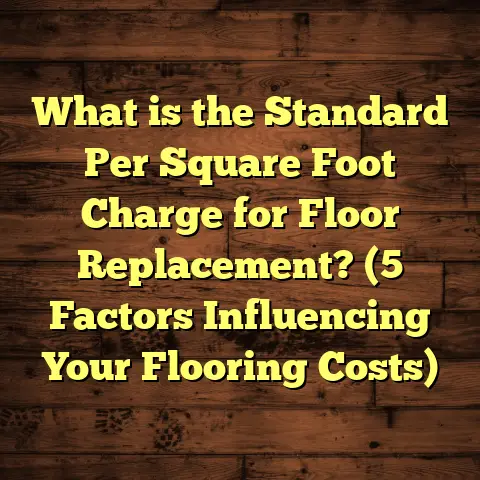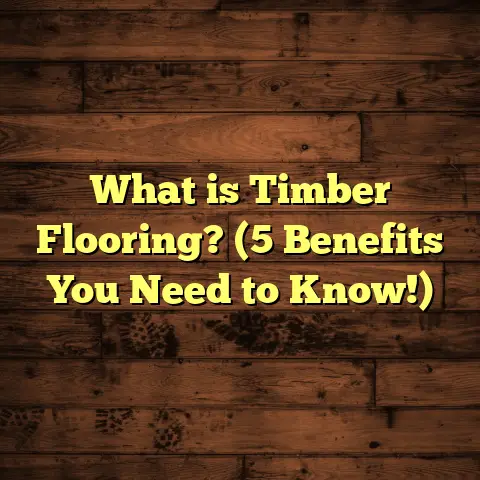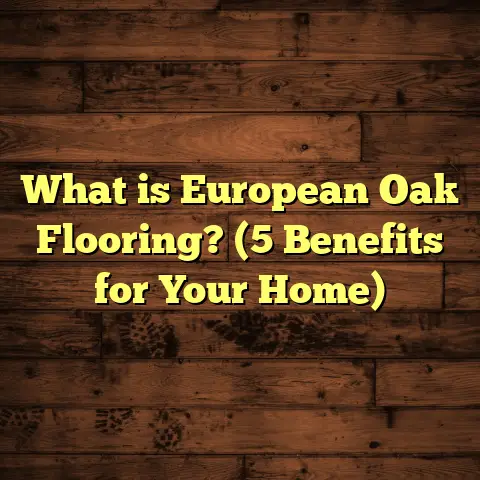What is Flooring in Interior Design? (5 Key Trends to Explore)
I remember the day I finished installing hardwood floors in a 3,000-square-foot home—a project that took nearly three weeks but completely transformed the space. At that moment, I understood how flooring isn’t just a base to walk on; it’s the backbone of interior design. Since then, I’ve worked on hundreds of flooring projects, each teaching me something new about how floors influence feel, function, and style in a home. Over time, I realized that flooring choices do more than impact aesthetics—they affect comfort, durability, acoustics, energy efficiency, and even emotional connection to a space.
If you’ve ever wondered what flooring really means in interior design or what trends are shaping the way we cover our floors today, let’s break it down together. Drawing from my hands-on experience and research, I’ll walk you through what flooring is, why it matters so much, and five key trends changing the game right now.
What Is Flooring in Interior Design?
When we say “flooring,” we’re talking about the material or covering that forms the surface layer of a floor inside any building. It’s the physical foundation you step on every day. But in interior design terms, flooring is much more than just functional—it’s a critical design element that helps define a room’s character.
Think of flooring as the silent partner in your home’s decor. It interacts with walls, furniture, lighting, and accessories to create harmony or contrast. When chosen well, flooring can unify a space or carve out distinct areas within an open plan.
From a technical standpoint, flooring must meet several criteria:
- Durability: Can it withstand foot traffic, impacts, moisture?
- Comfort: Is it pleasant underfoot? Does it add warmth?
- Aesthetics: Does it complement the style? Does color and texture fit the mood?
- Maintenance: Is it easy to clean or require special care?
- Cost: What fits the budget for materials and installation?
Flooring material options are incredibly diverse: hardwoods like oak or maple, engineered woods, laminates, vinyl (including luxury vinyl plank), various types of tile (ceramic, porcelain, stone), carpet, cork, bamboo—and sometimes combinations of these.
Here’s an interesting data point: The U.S. Flooring Market report from 2023 cited hardwood flooring as the largest segment by value with a market share of 38%, followed by vinyl and tile. This shows hardwood’s lasting popularity but also growing interest in resilient and cost-effective alternatives.
Why Flooring Plays a Bigger Role Than You Think
Have you ever felt instantly comfortable walking barefoot onto a warm wood floor? Or noticed how a room with plush carpet feels cozy and quiet? Flooring affects our daily experience in subtle but powerful ways.
Impact on Room Ambiance
The type and color of flooring can make rooms feel larger or smaller. Light-colored floors reflect more light, making spaces feel airy and open. Dark floors absorb light and create intimate, grounding environments.
The texture also influences perception—smooth polished floors suggest modern minimalism while hand-scraped wood or textured stone adds rustic charm.
In my early days as a contractor, I worked on a small city apartment where the client wanted to maximize perceived space. We installed a pale ash hardwood with matte finish throughout. The difference was dramatic—the room felt twice as spacious and bright after installation.
Acoustic Effects
Floors influence sound absorption and noise levels. Hard surfaces like tile or hardwood reflect sound and can amplify footsteps or voices. Carpets or cork reduce noise by absorbing sound waves. This matters especially in multi-story homes or apartments.
Once I installed cork flooring in a nursery because it offered natural sound dampening. The parents were thrilled that their baby’s cries didn’t echo through the whole house anymore.
Energy Efficiency
Certain flooring materials provide insulation benefits. Cork and carpet offer warmth in colder months by trapping heat near the surface. Stone and tile stay cool in summer but can feel chilly in winter unless paired with radiant floor heating.
In one project with radiant heating beneath tile floors, the client reported lower energy bills and increased comfort during harsh winters.
Influence on Resale Value
From experience and market data, quality flooring significantly boosts property value. The National Association of Realtors (NAR) found that homes with hardwood floors sell faster and often at higher prices than those with carpet or worn flooring.
I often advise clients investing in their homes that upgrading to hardwood or engineered wood floors is one of the best ways to improve resale appeal.
My Flooring Journey: Lessons from Real Projects
I want to share some personal stories to give you a sense of how varied flooring needs can be.
Story 1: The Family-Friendly Floor
A family with three kids and two dogs approached me wanting floors that could handle spills, scratches, and rough play but still look stylish. They loved the look of wood but worried about damage.
We settled on waterproof luxury vinyl plank (LVP) with woodgrain texture. It gave them the warmth of wood without worrying about moisture or scratches. Two years later, they told me how easy cleanup was after birthday parties and muddy shoes.
This project taught me that technology has advanced enough to offer alternatives that combine beauty and practicality for busy homes.
Story 2: The Vintage Charm Restoration
In another case, I helped restore an old farmhouse with original wide plank pine floors that were badly worn. Instead of replacing them entirely, we refinished the planks using eco-friendly stains and finishes that preserved character while improving durability.
The owners appreciated keeping the home’s history intact while updating it for modern living.
This showed me how flooring can connect us to a home’s story while supporting today’s needs.
5 Key Flooring Trends You Should Know About
Now for some trends I’m seeing more often on my job sites and through industry research:
1. Sustainable & Eco-Friendly Flooring Choices
More homeowners ask about sustainability than ever before. Materials like bamboo and cork are popular because they’re renewable and biodegradable. Bamboo grows quickly—up to 3 feet per day—which means harvesting doesn’t cause deforestation like traditional hardwood might.
Cork is harvested from tree bark without cutting down trees at all—a win for sustainability. Plus cork offers natural insulation and softness underfoot.
Recently I installed cork flooring in a yoga studio because it provides cushioning and reduces noise—perfect for mindful movement spaces.
According to a 2024 industry report by Green Building Supply, sales of eco-friendly flooring materials grew by 35% over two years as awareness rises about environmental impact.
2. Mixed Material Floors for Visual Interest
Combining different materials creates texture and zones within open spaces without walls. For example:
- Wood planks combined with ceramic or porcelain tiles around wet areas like kitchens.
- Stone inserts within hardwood for decorative patterns.
- Carpet runners layered over wood in hallways or stairs for warmth plus durability.
In one project blending reclaimed barn wood with natural stone tile created a rustic yet elegant entryway.
These mixed floors let you tailor function with style—durable tile where moisture is common; soft carpet where comfort matters; warm wood in living areas.
3. Wide Plank Hardwood Floors
Wide plank floors are back in style for their bold statement and ability to showcase wood grain beautifully. Planks wider than 7 inches are trending because they make rooms feel larger with fewer seams visible.
I helped install wide plank oak floors in a loft conversion recently—clients loved how it anchored their industrial-style interiors without feeling cold or sterile.
According to NWFA data from 2023, wide plank hardwood sales rose 22% over previous years due to popular demand for natural textures.
4. Textured & Hand-Scraped Finishes
Textured finishes add personality while hiding scratches better than smooth surfaces. Hand-scraped wood has subtle ridges from artisans’ tools creating a rustic look full of character.
Wire-brushed finishes remove soft fibers revealing deeper grain patterns—great for homes wanting subtle depth without too much distressing.
For high-traffic areas in family homes or commercial spaces I often recommend textured hardwood because it holds up better over time.
5. Waterproof Luxury Vinyl Plank (LVP)
Luxury vinyl plank flooring has evolved dramatically—now you get realistic textures mimicking wood or stone but with superior waterproofing and easy maintenance.
I’ve installed LVP in bathrooms, kitchens, basements—anywhere moisture is an issue but style can’t be sacrificed.
Market research shows waterproof vinyl sales increased 40% globally in 2023 as homeowners seek durable yet beautiful solutions.
How to Choose Flooring That Suits You
Choosing flooring isn’t always straightforward. It’s a mix of budgets, needs, tastes, and practicalities.
Here are some tips I share with clients:
- Assess your lifestyle: Kids? Pets? Heavy foot traffic? Look for durable scratch- and stain-resistant surfaces.
- Think about comfort: Do you want something soft like carpet or cork? Or sleek like tile or wood?
- Consider maintenance: Some floors need sealing/refinishing every few years; others just need mopping.
- Match your design style: Rustic cabins lean towards hand-scraped planks; modern minimalists prefer clean lines.
- Plan your budget: Installation costs vary widely—vinyl can be as low as $2 per sq ft including install; hardwood may run $8-$15+ per sq ft.
- Factor climate: Cold climates benefit from insulated floors; humid climates require moisture-resistant materials.
In one case study from last year, a young couple chose laminate over hardwood because they wanted wood look but had limited budget and wanted simpler upkeep. It fit their lifestyle perfectly for now—and they could upgrade later if they wanted.
Flooring Material Breakdown: Pros & Cons With Data
Let me give you a detailed look at common flooring materials including lifespan estimates and maintenance notes:
| Material | Average Lifespan (Years) | Maintenance | Cost/Sq Ft Installed | Pros | Cons |
|---|---|---|---|---|---|
| Hardwood | 25-100 | Refinishing every 7-10 years | $8-$15 | Timeless look; high resale value | Sensitive to moisture; costly |
| Engineered Hardwood | 20-30 | Occasional refinishing | $7-$12 | More moisture resistant than solid | Less refinishable than hardwood |
| Laminate | 10-30 | Low | $3-$8 | Affordable; easy install | Can’t refinish; moisture sensitive |
| Luxury Vinyl Plank (LVP) | 15-25 | Very low | $4-$7 | Waterproof; durable | Not as eco-friendly |
| Porcelain/Ceramic Tile | 50+ | Grout cleaning | $7-$15 | Durable; waterproof | Hard and cold underfoot |
| Carpet | 5-15 | Regular vacuuming & deep clean | $3-$10 | Soft; warm | Stains easily; wears quickly |
| Cork | 20+ | Occasional sealing | $6-$12 | Soft; insulating; eco-friendly | May dent under heavy furniture |
What I’ve Learned From Flooring Installation Challenges
Not every project goes smoothly—sometimes unexpected issues arise that affect material choice or installation technique:
- Moisture Issues: In basements or bathrooms where moisture is high, selecting waterproof materials or adding vapor barriers is crucial.
- Subfloor Problems: Uneven subfloors cause squeaks or damage later—sometimes repairs double project time.
- Color Matching: Getting stain colors perfect requires testing samples under home lighting conditions.
- Noise Control: Hard floors need rugs or acoustic underlays in apartments.
- Budget Adjustments: Sometimes clients have to balance dream floors with reality—finding great alternatives matters.
One tricky project involved restoring original hardwood floors under decades of paint layers in an old Victorian home. It took extra sanding and refinishing but saved original character many wanted preserved.
Case Study: Transforming a Modern Loft With Flooring
A recent project involved an urban loft client wanting sleek modern appeal but with warmth for entertaining guests. They chose wide plank European oak with wire-brushed texture throughout open plan living/kitchen/dining area.
We paired it with area rugs for softness near seating areas and porcelain tile near kitchen counters for spill resistance.
The result was striking—the floor became a unifying backdrop bringing together minimalist furniture and bold art pieces.
The client reported improved acoustics and loved how easy cleaning was after parties.
How Technology Is Changing Flooring
New technologies impact both manufacturing and installation:
- Click-lock systems make floating floors easy for DIYers.
- Digital printing allows vinyl tiles/planks to mimic natural materials closely.
- Low-VOC finishes improve indoor air quality.
- Underfloor heating compatibility expands comfort options.
These innovations mean more choices at different price points without sacrificing quality or style.
Final Thoughts — What Flooring Means For Your Home
Flooring is foundational—not only literally but emotionally—to your home’s interior design. It shapes how you feel when you enter a room; it influences your daily routines; it impacts your property’s value.
From sustainable cork to luxurious wide plank hardwoods, there’s a world of options ready to suit your personality and lifestyle.
I encourage you to think about your floors not just as surfaces beneath your feet but as key players in making your house truly feel like home.
Got questions about which flooring fits your needs best? Want advice on maintenance? I’m here anytime to chat about your next floor project!





